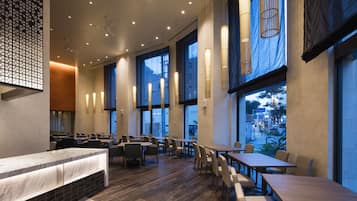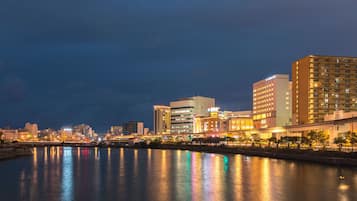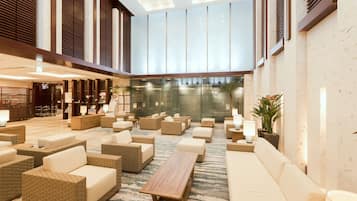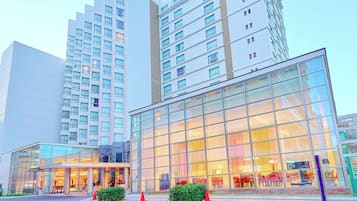Our Naha Travel Essentials includes important information you need to enjoy your trip to Okinawa's capital of Naha. We will go over aspects of the city you need to know, including the local climate, travel seasons, outlet types, currency and emergency phone numbers. Additionally, you will learn about local transport options when it comes to getting to your hotel and getting around town.
Once you've arrived in Naha, you'll need things to do. Our guide will show off a great selection of activities in addition to several annual events you may not want to miss. With this guide, everything you need to enjoy your Naha holiday is at your fingertips.
When is the best time to travel to Naha?

- The climate in Naha is relatively comfortable all year long, including the few weeks during the summer where it's at its hottest.
- Rainfall is most common in August followed by May, which both experience more than 30 centimetres of precipitation throughout the month.
- Temperatures in Naha peak around July every year with an average high of 32.1 degrees Celsius, but August and September are fairly warm as well with highs over 30 degrees on average.
- The busiest time for travel in Naha is spring thanks to the inviting weather and variety of things to do, but those looking to get away from crowds can also enjoy winter and autumn, as the temperatures are relatively comfortable even for warm weather travellers.
Naha basics

- Plug type: Naha uses Type A and Type I plugs with the occasional use of Type B outlets.
- Electricity: City outlets are 100 V with a 60 Hz frequency.
- Currency: Naha, like all of Japan, uses the Japanese yen.
- International dialling code: The international dialling code is +81.
- Emergency telephone number: In Naha, you may call 110 for police, 118 for coast guard and 119 for fire and ambulance.
Ezek is érdekelhetnek
- 10 Best Family Things to Do in Naha

10 Best Family Things to Do in Naha
Japan - 10 Best Things to Do After Dinner in Naha

10 Best Things to Do After Dinner in Naha
Japan - 10 Best Things to Do in Naha

10 Best Things to Do in Naha
Japan
How to get to my hotel in Naha?

Getting to Naha is fairly easy no matter where you're coming from. There's an international airport directly in the city itself about 12 minutes from the city centre, but international flights only connect to nearby countries. If you're travelling from Europe, you'll probably have to stop by mainland Japan first before booking another domestic flight to Naha in Okinawa. Of course, you can also take a ferry into the city from the southern mainland. After arriving, getting a car to your hotel is easy.
Airports
Flying into Naha means arriving at Naha Airport, a convenient airport little more than 5 kilometres from the city centre. It has connections to several nearby countries as well as to major airports in mainland Japan, such as Osaka and Tokyo. Flying from Europe means stopping by one of those mainland cities first before getting on a connecting flight to Naha.
Train stations
You won't find any train stations in Naha that you can reach from outside of the island. If you're already in Okinawa, however, you can take the Okinawa Urban Monorail system to Akamine Station.
Ports
The port in Naha offers ferry travel, but only if you're travelling from Kagoshima, as that's the only other port that connects to Naha.
How to get around Naha?

Travel tips
The Okinawa prefecture has been working to make travel throughout its collection of islands easier, so if you plan on simply exploring what Naha has to offer, you'll find that travel is remarkably simple. A vast bus network exists throughout the city along with a monorail network, though Naha offers several taxis too. If you plan on using the bus a lot, you can even enjoy special passes that offer unlimited travel throughout Naha at a discounted rate available at local bus terminals.
Underground system
While there is no underground system in Naha, you can use the Okinawa Urban Monorail, which is an above-ground monorail system that can get you around town. In fact, this train can get you all the way to Urasoe if you like. Most of the rail line is in Naha, however, stretching all the way from the Naha Airport station to the Ishimine Station 12.84 kilometres away.
Taxi and rideshare apps
Several taxi companies run throughout Naha, and they tend to be cheaper than taxis on the Japanese mainland. Fares tend to be modest compared to places like Tokyo and Osaka, so using taxis is more budget-friendly than you might think. Rideshare options are available as well. Uber doesn't operate in Naha, but apps like JapanTaxi and Didi-Rider do.
Bus network
Naha has a comprehensive bus network that can get you just about anywhere in the city. Limited-area Naha passes are available for a discount if you plan to stay in the city. If you're not using the pass, you can pay using an OKICA IC card, which is available at monorail stations, some convenience stores and bus depots. If you're paying in cash, don't use anything larger than a ¥1,000 bill.
Car hire
Car hire is available throughout the city, though they're most prominent by the airport. All you need to rent a car in Naha is a driver's licence, an international driver's permit and to be at least 18 years of age. Despite most images of Okinawa depicting serene beaches and small villages, the city of Naha is quite large with plenty of parking.
Bicycle hire
Bike hire is among the best ways to travel throughout Naha, as it's notably a bike-friendly city. Bike share services are available as well, including Hello Cycling, which can be booked in advance online. Just remember that travelling by bike makes it especially easy to realise just how large Naha is.
What are the main annual events in Naha?

All-Okinawa Eisa Festival / Zento Eisa Matsuri 全島エイサー祭り
- When: Late August
- What: The All-Okinawa Eisa Festival is a thrilling festival that features numerous performances, dancing and parades celebrating traditional Eisa, which is a style of folk dancing immersed in obon holiday rites.
- Where: Koza Music Town
Naha Hari Dragon Boat Races 那覇ハーリー
- When: May
- What: The Hari Dragon Boat Races feature fascinating and thrilling races between dragon boats, which are massive long boats holding several dozen rowers in a contest of strength and teamwork.
- Where: Naha Port
Naha Tug-of-War / Naha Otsunahiki 那覇大綱挽
- When: Mid October
- What: The Naha Otsunahiki is an iconic tug of war challenge in which teams battle to see who can pull a rope past a certain distance, or who has pulled it the furthest after 30 minutes. Winners are often given a piece of the massive rope to take home to memorialise their victory.
- Where: Onoyama Sports Park
What are the main landmarks in Naha?

Shurijo Castle
Shurijo Castle is a historic castle built in the Ryukyu style with stone walls that has lasted through several serious disasters. It was nearly destroyed in the Battle of Okinawa near the end of World War 2, and it suffered fire damage in 2019. Still, it lives on with several parts still preserved and the rest being rebuilt as a World Heritage Site.
Umikaji Terrace Seagajima
Umikaji Terrace Seagajima is a fun shopping destination close to the airport where you'll find a variety of sundry shops and restaurants among bright white buildings. The array of items on offer is quite impressive, especially if you stop by the local hamburger shop. The Senaga Teahouse also has a delicious item called Watayuki, a shaved ice treat that's a first for Okinawa.
Naminoue Shrine
The Naminoue Shrine is a Shinto shrine that serves as the primary shrine for the entire prefecture. At this shrine, crisp sea air rises to greet you as you tower on a cliff above the waters and Naminoue Beach. Some of the smaller shrines are relatively new, being built in the 1990s compared to the historic main hall, which dates back centuries.
Okinawa Prefectural Museum & Art Museum
The Okinawa Prefectural Museum & Art Museum is a comprehensive museum that specifically focuses on the history and culture of Okinawa, to the point that the building itself is constructed of Okinawan limestone in an effort to emulate native gusuku castles. Visitors can explore either the artistic side, the natural history side or both sides depending on the kind of ticket chosen.
Ez a cikk a Go Guides szerkesztőségének véleményét ismerteti. A Hotels.com ellentételezést nyújt a szerzőknek az ezen a weboldalon megjelenő írásaikért; az ilyen ellentételezések körébe tartozhat az utazási és egyéb költségek megtérítése.
Kezdj hozzá az utad tervezéséhez!
Hol érdemes megszállni Naha területén

Okinawa NaHaNa Hotel & Spa
Okinawa NaHaNa Hotel & Spa

JR KYUSHU HOTEL Blossom Naha
JR KYUSHU HOTEL Blossom Naha

Tokyu Stay Okinawa Naha
Tokyu Stay Okinawa Naha

Hotel JAL City Naha
Hotel JAL City Naha

OMO5 Okinawa Naha by Hoshino Resorts
OMO5 Okinawa Naha by Hoshino Resorts

Novotel Okinawa Naha
Novotel Okinawa Naha

Hyatt Regency Naha, Okinawa
Hyatt Regency Naha, Okinawa

Hotel Gracery Naha
Hotel Gracery Naha

Okinawa Hinode Resort and Hot spring Hotel
Okinawa Hinode Resort and Hot spring Hotel

Mercure Okinawa Naha
Mercure Okinawa Naha
Kapcsolódó bejegyzések
- 10 Best Family Things to Do in Naha

10 Best Family Things to Do in Naha
Japan - 10 Best Things to Do After Dinner in Naha

10 Best Things to Do After Dinner in Naha
Japan - 10 Best Things to Do in Naha

10 Best Things to Do in Naha
Japan - 10 Best Places to Go Shopping in Naha

10 Best Places to Go Shopping in Naha
Japan - 10 Great Restaurants in Naha

10 Great Restaurants in Naha
Japan - 10 Most Popular Streets in Naha

10 Most Popular Streets in Naha
Japan - 10 Best Markets in Okinawa

10 Best Markets in Okinawa
Japan - 10 Best Local Dishes from Okinawa

10 Best Local Dishes from Okinawa
Japan
